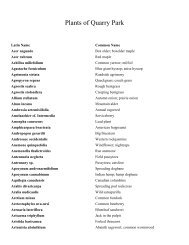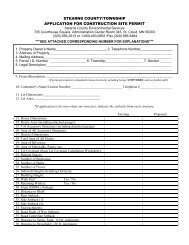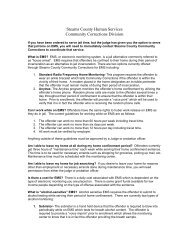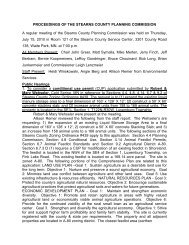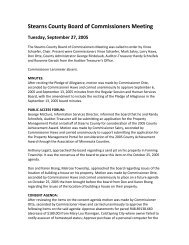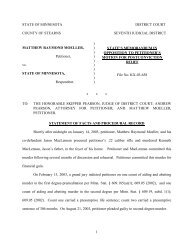The Eleven Primary Noxious Weeds of Minnesota - Stearns County ...
The Eleven Primary Noxious Weeds of Minnesota - Stearns County ...
The Eleven Primary Noxious Weeds of Minnesota - Stearns County ...
Create successful ePaper yourself
Turn your PDF publications into a flip-book with our unique Google optimized e-Paper software.
<strong>The</strong> <strong>Eleven</strong> <strong>Primary</strong> <strong>Noxious</strong><br />
<strong>Weeds</strong> <strong>of</strong> <strong>Minnesota</strong><br />
Applied Weed Science<br />
Krishona Martinson, PhD; Beverly Durgan, PhD; and<br />
Roger Becker, PhD, University <strong>of</strong> <strong>Minnesota</strong> Extension<br />
Connecting Community Needs and University Resources<br />
<strong>The</strong> following eleven <strong>Primary</strong> <strong>Minnesota</strong><br />
<strong>Noxious</strong> <strong>Weeds</strong> are prohibited in<br />
<strong>Minnesota</strong> because they are difficult to<br />
control or are injurious to public health, the<br />
environment, roads, crops, livestock, and<br />
property. <strong>The</strong>se weeds must be controlled<br />
on all public and private lands.<br />
Annuals: annual weeds germinate and emerge<br />
from seed and complete their life cycle in one<br />
growing season. <strong>The</strong>re is one annual weed on<br />
the <strong>Minnesota</strong> <strong>Noxious</strong> Weed List, hemp.<br />
Hemp mature plant<br />
Bull thistle rosette<br />
Hemp leaf<br />
Bull thistle flowers<br />
Hemp (Cannabis sativa) is also known as<br />
marijuana. <strong>The</strong> plant is two to ten feet tall,<br />
has rough, hairy stems, and leaves that are<br />
divided into 5 to 11 hairy leaflets (divisions<br />
within a leaf) with notched edges. Flowers<br />
are green in color. Hemp is found in rich,<br />
low, wet areas, but can also be found in<br />
waste areas, farm sites, ditches, pastures and<br />
fields throughout <strong>Minnesota</strong>.<br />
Biennials: requires two growing seasons to<br />
complete their life cycle. Biennials form a<br />
rosette (cluster <strong>of</strong> leaves close to the ground,<br />
like dandelions) the first year and during the<br />
second year they develop a flower stalk,<br />
flower, and produce seeds. <strong>The</strong> four biennial<br />
weeds on the <strong>Minnesota</strong> <strong>Noxious</strong> Weed List<br />
are: plumeless thistle, musk thistle, bull<br />
thistle, and garlic mustard.<br />
www.extension.umn.edu<br />
Garlic mustard mature plant<br />
Garlic mustard flower<br />
Bull thistle (Cirsium vulgare) grows to a<br />
height <strong>of</strong> two to four feet. Leaves are dark<br />
green, coarsely lobed and end in a long,<br />
sharp spine. <strong>The</strong> upper leaf surface is<br />
covered with short, stiff hairs and spines,<br />
while the underside <strong>of</strong> the leaf is covered<br />
with dense, woolly, gray hair. Flowers are<br />
reddish-purple and surrounded by spines.<br />
Bull thistle is primarily found in pastures,<br />
waste areas, and along roadsides throughout<br />
<strong>Minnesota</strong>.<br />
<strong>Noxious</strong> <strong>Weeds</strong>
Applied Weed Science<br />
Connecting Community Needs and University Resources<br />
Musk thistle rosette<br />
Plumeless thistle rosette<br />
Canada thistle mature plant<br />
Musk thistle flower<br />
Plumeless thistle flower<br />
Canada thistle rosette<br />
Garlic mustard (Alliaria petiolata) grows three to four<br />
feet in height. Lower leaves are heart or kidney<br />
shaped, while upper leaves are toothed, and triangular<br />
in shape. Flowers are white and clustered on the top<br />
<strong>of</strong> the stem. Young plants smell like garlic. Garlic<br />
mustard is found in the forest understory, at the edges<br />
<strong>of</strong> wooded areas near trails, roadsides and areas where<br />
trees have been removed.<br />
Musk thistle (Carduus nutans), also called nodding<br />
thistle, grows to a height <strong>of</strong> three to six feet. <strong>The</strong><br />
leaves are dark bluish-green with light green midribs<br />
(central vein in the leaf) and white margins that end<br />
in a white to yellowish spine. <strong>The</strong> leaves are coarsely<br />
lobed and slightly wavy. <strong>The</strong> leaves have little or no<br />
hair. Flowers are large, purplish, surrounded by spines<br />
and <strong>of</strong>ten droop. Musk thistle is primarily found in<br />
Southern <strong>Minnesota</strong> in pastures, waste areas, and<br />
roadside, and prefers moist soils.<br />
Plumeless thistle (Carduus acanthoides) grows to a<br />
height <strong>of</strong> three to six feet. <strong>The</strong> leaves are narrow, deeply<br />
divided, with scattered hair on the upper surface and<br />
dense white hair on the lower surface. Lobes on the<br />
leaves end in white to yellowish spines. Flowers are<br />
reddish-purple with spines. Plumeless thistle is found<br />
primarily in pastures, waste areas, and along roadsides,<br />
however, it prefers sandy, well-drained soils.<br />
Perennials: A perennial weed can live for two or more<br />
years. <strong>The</strong> six perennial weeds on the <strong>Minnesota</strong> <strong>Noxious</strong><br />
Weed List are perennial sowthistle, Canada thistle, leafy<br />
spurge, field bindweed, poison ivy and purple loosestrife.<br />
Canada thistle (Cirsium arvense) grows to a height <strong>of</strong><br />
two to five feet. <strong>The</strong> stems are grooved and become<br />
hairy as the plant matures. <strong>The</strong> leaves have crinkled<br />
edges, spiny margins, and are somewhat lobed. Flowers<br />
are lavender, white or reddish-purple without spines.<br />
Canada thistle is found in cultivated fields, pastures,<br />
waste areas and roadsides throughout <strong>Minnesota</strong>.<br />
Perennial sowthistle (Sonchus arvensis) grows to a<br />
height <strong>of</strong> three to seven feet. <strong>The</strong> stems contain a<br />
milky juice called latex. <strong>The</strong> basal leaves are narrow<br />
and deeply lobed. <strong>The</strong> leaves attached to the stem are<br />
toothed, lobed, and have spiny edges. Flowers are<br />
yellow. Perennial sowthistle is found in cultivated<br />
fields, pastures, waste areas, and along roadsides<br />
throughout <strong>Minnesota</strong>.
Leafy spurge (Euphorbia esula) grows to a<br />
height <strong>of</strong> two to three feet. <strong>The</strong> stems<br />
contain a milky juice called latex. <strong>The</strong><br />
leaves are bluish-green, narrow and linear in<br />
shape. Leafy spurge produces a flat-topped<br />
cluster <strong>of</strong> yellowish-green flower-like<br />
structures called bracts. Leafy spurge grows<br />
primarily in pastures, waste areas, and along<br />
roadsides throughout <strong>Minnesota</strong>.<br />
Canada thistle flowers<br />
Perennial sowthistle rosette<br />
Perennial sowthistle mature plant<br />
Perennial sowthistle flowers<br />
Field bindweed (Convolvulus arvensis), also<br />
known as creeping jenny or morningglory,<br />
grows prostrate (along the ground), and can<br />
climb on nearby objects. <strong>The</strong> plants can<br />
spread two to seven feet. <strong>The</strong> leaves are<br />
arrow-shaped with two basal lobes. <strong>The</strong><br />
flowers are white to pink and are funnel<br />
shaped. Field bindweed is found in most<br />
cultivated fields, gardens, lawns, waste areas<br />
and along roadsides throughout <strong>Minnesota</strong>.<br />
Poison ivy (Toxicodendron radican) is a native<br />
species and grows primarily as a woody vine,<br />
but if growing in full sunlight it may grow as<br />
a shrub up to several feet tall. <strong>The</strong> leaf<br />
contains three leaflets that are pointed at the<br />
tip and shiny. Flowers are yellowish-green<br />
and produce a grayish cluster <strong>of</strong> fruit. All<br />
parts <strong>of</strong> the plant contain a poisonous<br />
material that causes blistering <strong>of</strong> the skin.<br />
Poison ivy grows along stream banks, edges<br />
<strong>of</strong> paths and roadsides, fencerows, woodland<br />
and other non-cultivated sites.<br />
www.extension.umn.edu<br />
Leafy spurge mature plant<br />
Leafy spurge flowers<br />
Purple loosestrife (Lythrum salicaria) is a<br />
wetland weed that can reach heights <strong>of</strong> seven<br />
feet. Leaves are linear (long and narrow) in<br />
shape, hairy and have smooth edges. Flowers<br />
are purple and found at the top <strong>of</strong> the plant.<br />
Purple loosestrife grows in wets soils,<br />
including meadows, pastures, cattail marshes,<br />
streams, river banks, lake shores and ditches.<br />
Control <strong>of</strong> <strong>Noxious</strong> <strong>Weeds</strong><br />
Chemical control <strong>of</strong> annuals works best<br />
when a herbicide is applied in the spring to<br />
actively growing, young weeds. Mechanical<br />
control, such as mowing, is also effective<br />
against annuals.<br />
<strong>Noxious</strong> <strong>Weeds</strong>
Applied Weed Science<br />
Connecting Community Needs and University Resources<br />
Field bindweed mature plant<br />
Poison ivy leaf<br />
Purple loosestrife mature plant<br />
Reviewers: Jeanie Katovich, PhD and Patrick Weicherding, PhD, University <strong>of</strong> <strong>Minnesota</strong>; and Anthony Cortilet, <strong>Minnesota</strong> Department <strong>of</strong> Agriculture<br />
Photos provided by the University <strong>of</strong> <strong>Minnesota</strong> Stand Memorial Herbarium and Jeanie Katovich, PhD, University <strong>of</strong> <strong>Minnesota</strong>.<br />
In Partnership...<br />
This fact sheet was<br />
funded by the<br />
<strong>Minnesota</strong> Racing<br />
Commission<br />
Field bindweed leaf<br />
Berries (fruit) <strong>of</strong> poison ivy<br />
Purple loosestrife flower<br />
Control <strong>of</strong> biennials, via herbicides, are<br />
most effective when applied during the first<br />
year’s growth. If treatment is delayed until<br />
the second year, early season application <strong>of</strong><br />
a herbicide, or mowing, before bloom is<br />
recommended.<br />
Methods <strong>of</strong> perennial weed management<br />
fall into three categories: (a) cultural - such<br />
as crop rotation, (b) mechanical - such as<br />
tillage, and (c) chemical - herbicides.<br />
Effective management <strong>of</strong> perennial weeds<br />
requires a combination <strong>of</strong> all three<br />
methods. Fall herbicide applications can<br />
provide some <strong>of</strong> the best perennial weed<br />
control during the season. However, it is<br />
important to realize that herbicides alone,<br />
or one herbicide application will generally<br />
not eradicate a perennial weed population.<br />
Application <strong>of</strong> herbicides in spring, or<br />
frequent moving during the summer is also<br />
effective in controlling growth until fall.<br />
However, mowing alone may take several<br />
growing seasons to effectively control<br />
perennial weed populations.<br />
Biological control, using host-specific<br />
natural enemies, has shown to be successful<br />
on large populations <strong>of</strong> noxious weeds (like<br />
leafy spurge and purple loosestrife) where<br />
traditional weed management methods are<br />
logistically or environmentally impractical.<br />
Each year, the University <strong>of</strong> <strong>Minnesota</strong><br />
publishes Cultural and Chemical Weed<br />
Control in Field Crops. This publication<br />
includes control strategies (cultural,<br />
mechanical and chemical) for many <strong>of</strong> the<br />
noxious weeds. <strong>The</strong> publication is<br />
available on-line only at<br />
http://appliedweeds.coafes.umn.edu/<br />
www.extension.umn.edu<br />
<strong>Noxious</strong> <strong>Weeds</strong>




